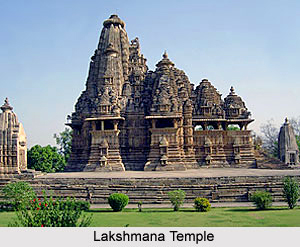 Lakshmana temple enshrines the mystic form of Lord Vishnu called Vaikuntha, which is 1.3 m. (4 ft.) high with three faces of the Lion, Man, and Boar. The temple was affiliated to the Vaishnavite Pancharatra sect of the Kashmir school, which worshipped Vishnu in this composite form. Madhya Pradesh is a land of Great antiquity. And the Khajuraho Temple is the one which depicts a sensuous poetry carved in stone. The temple`s inscription states that King Yashovarman who built this splendid temple to house the Vaikuntha image that he acquired from his overlord, the Pratihara king, who in turn had got it from the ruler of Chamba region. His son Dhangadeva consecrated the temple in AD 954.
Lakshmana temple enshrines the mystic form of Lord Vishnu called Vaikuntha, which is 1.3 m. (4 ft.) high with three faces of the Lion, Man, and Boar. The temple was affiliated to the Vaishnavite Pancharatra sect of the Kashmir school, which worshipped Vishnu in this composite form. Madhya Pradesh is a land of Great antiquity. And the Khajuraho Temple is the one which depicts a sensuous poetry carved in stone. The temple`s inscription states that King Yashovarman who built this splendid temple to house the Vaikuntha image that he acquired from his overlord, the Pratihara king, who in turn had got it from the ruler of Chamba region. His son Dhangadeva consecrated the temple in AD 954.
Architecture of Lakshmana Temple
The Lakshmana temple has five-shrines or Panchayatana complex and stands in the centre of a high platform along with its four subsidiary shrines in the corners. All along the platform, a continuous sculptural pathway depicts scenes of everyday life, a royal hunt, battle, traders, dancers and musicians, dancer conversing with a religious teacher and elixir preparation amidst an orgy.
The exterior wall of the main temple is divided into two zones of sculptures depicting graceful apsaras, snake goddesses, griffins, and couples in the recesses. The upper zone carries the images of the different forms of Vishnu while Lord Shiva occupies a significant position on the lower zone. One of the more noteworthy sculptures on the southeast side is that of two males ecstatically dancing with castanets in their hands. The front facade of the temple has an image of the Sun god holding two lotuses.
The architect of Lakshmana temple was the first to place erotic groups on the juncture wall of the mahamandapa and the sanctum. This is the only temple in Khajuraho that depicts the avatars of Vishnu on its jambs, pairing Matsya (Fish), Varaha, and Vamana Avtar on the left jamb with Kurma (Tortoise), Narasimha, and Parasurama on the right jamb. The centre of the header is presided over by the Goddess Lakshmi.
The images of Vishnu`s incarnations are present in the three cardinal niches of the walls: Varaha in the south, Narasimha in the west, and Hayagriva (Horse necked one) in the north. In the upper western niche Vishnu-Narayana can be seen amidst his devotees at Svetadvipa, a mythic island mentioned in the Mahabharata .The three placid scenes of Vishnu-Narayana discoursing with the sages are interspersed with twelve panels depicting Krishna slaying or subduing demons. Sculptures of Lakshmi, Saraswati, Mahishasuramardini, Durga-Kshemankari with two lions, Tripura in meditation posture, and others are found in the niches of the sanctum and the mahamandapa. The planetary divinities (Grahas) play an important part in the iconography of the Baikuntha temple. In the interior of the temple they are represented on the door lintel of the sanctum, while on the exterior, their figures are placed around the temple in all niches of the plinth.











